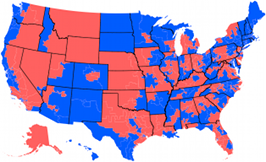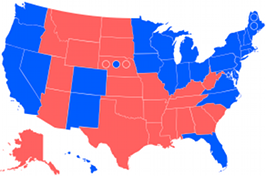I didn’t intend the second stage of my pollster grading series to come eleven days after my first stage, but then again I didn’t expect to suffer my worst cold in a long time, either.
So with my apologies for the unavoidable delay, we continue after a lost week by checking in on Public Policy Polling.
[More]
Like everyone else, Rasmussen Reports got two key Senate races wrong, making them big surprises on election night: Colorado and Nevada. Rasmussen also underestimated Barbara Boxer’s lead in California.
My mission since election day has been to find out why everyone got these three states in particular so wrong, while others were accurate. In the process, I’ve taken a good look at Rasmussen’s accuracy this year.
[More]
Today I started running the numbers to test my theory about why the polling was so wrong in key states this year, and I ran into a snag: my theory was not supported by my data. At least, the normal random fluctuations of polling were drowning out any relationship I hoped to find.
Much as Robert Millikan kept trying when he didn’t like his readings for the charge of the electron, I will press on. I need to find a way to sift through the noise, and I will find it.
Until then, thank you for your patience.
I know, I know. Where’s the free ice cream? I don’t have anything. It’s the offseason. Until the Presidential races start heating up (and they will faster than any of us would like them to) I’m only going to have so much to write about.
But I’m still cooking up my writeup on why some of the polling was so wrong. Promise.
The New York Times’ Nate Silver is now going after Rasmussen Reports again. After the primaries he said Rasmussen was in his crosshairs for ducking out on a number of races by not polling primaries.
According to Silver’s own chart though, Rasmussen polled twice as often as the second place firm, and is still Silver’s primary target. Funny that.
[More]
In order to test my theory as to why certain polls were wrong and others were right, I need to be sure I actually know which polls were wrong and which were right. And doing that testing again will require me to wait for the counts to complete, unfortunately.
So, we wait. I am taking suggestions on statewide races across the country, though.
As we wait for final and eventually certified counts to trickle in for the House races, and even wait for winners in two Senate races, it’s too soon to start digging in and finding out what we can about the polling this year.
I am concerned about just how wrong the polling was universally in several states, though, and am trying to research a possible angle (heh) on that.
Let’s call this an open thread if anyone has questions I might be able to answer.
Good Evening! Below the fold is an Associated Press chart of calls in progress.
4:25pm PT: AP has called it for Leahy, Coats, Paul, and DeMint. No surprises yet.
4:40pm PT: Portman not a surprising hold for Republicans, but it was called for him. Kasich’s inability to get a call yet just underscores his polling collapse in recent weeks.
More updates below the fold.
[More]
While I do find it amusing that the final Fox poll and the final PPP poll of Washington favor the opposite of what their respective biases are supposed to suggest (Fox shows Murray +2 and PPP shows Rossi +2), today I am content to wait for returns and find what I can in them.
Because starting tomorrow the offseason work begins.
[More]
And with my final survey of the House Generic polling done, it’s time to make my final survey of the Senate polling this year, now that it’s already election eve.
Last week the range of possibilities seemed to narrow. I expect that to continue, but let’s see.
[More]
This is it. Today’s is my final survey of the Generic Ballots. This is the last time this year I’ll ask Swingometer about the 2010 House elections.
Last week Republicans took their second straight week of a 57 seat projected gain. Will they hit 60? Will they fall below the 1994 benchmark instead?
[More]


 House of Representatives Swingometer
House of Representatives Swingometer Electoral College Swingometer
Electoral College Swingometer